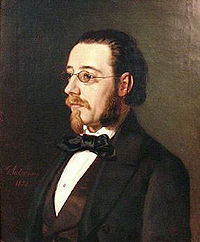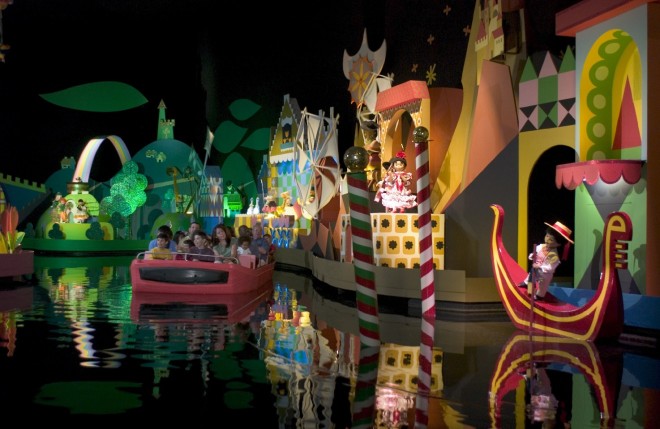This week’s theme is…Rivers! Always in motion, rivers are nature’s steady, majestic channels, flowing with water day and night. They have served as inspiration for artists and musicians in countless ways. This week we examine some examples of this.
Rivers, Day 4 – The Moldau by Bedrich Smetana

Have you ever been to Disneyland? For as long as I can remember I have had relatives living in Southern California, and so I have had a handful of opportunities. I even have step grandparents who live in Anaheim, the same city as Disneyland. I must confess that I have enjoyed my time at Disneyland – I know some people don’t like it. I also went to Disney World once, although it was a bit more overwhelming. Disneyland has sort of a small-town charm about it in comparison with its behemoth cousin in Orlando. One fun story about Disney World though…
We went for a week and stayed in one of the resorts there. Since we had a few days to kill, we ended up going to the Magic Kingdom a couple times. One of the times we went must have been a weeknight or some other low-traffic time because there was barely any line for Thunder Mountain, that terrific train roller coaster with all the campy mining town scenery.

It’s a really fun ride and, to our delight, there was hardly any line for it that evening. Every other experience I’ve ever had with a Disney park saw us waiting at least a half hour to board the high-demand rides, but that night we must have ridden Thunder Mountain at least 5 times. With a wait time of barely 10 minutes, we delightedly passed a considerable amount of that evening riding Thunder Mountain again and again.
One of the things that I find so enchanting about Disneyland is the creative and ingenious mix of mechanical rides there. If you exclude the simulators (Star Tours, Body Wars) and the child-oriented rides (teacups, carousel, flying elephants), I would say the remaining rides fall into two categories: roller coasters and dark rides. Thunder Mountain is a roller coaster. So are Space Mountain and the Matterhorn. Roller coasters use a buildup of potential energy to unleash a thrilling and intense ride which affects you viscerally, at the core level. On all roller coasters you strap yourself in and surrender to the unrelenting physical forces which you feel in your gut. Some parks, like Great America, form their image based on roller coasters of extreme speed, height, and special features like inverting. Disney’s roller coasters are fun, but for different reasons. They are less intense physically (they are still very effective) and more immersive. But they are roller coasters, and achieve their effects mostly through physical forces.
Opposed to roller coasters are dark rides. The effect of the dark ride is achieved through carefully crafted ambiance and the development of a story line or succession of scenes. The ride itself is tame and slow, but the enclosed scenery through which it winds is captivating. Some of Disneyland’s most famous attractions are dark rides, including Pirates of the Caribbean, the Haunted Mansion, and It’s a Small World.

The Magic Kingdom features other enjoyable dark rides like Peter Pan, Alice In Wonderland, and Mr. Toad’s Wild Ride. Universal Studios has a dark ride based on E.T. in which passengers board cars that resemble bicycles and experience E.T.’s flight across the sky. Part of the beauty of the Disneyland experience is the very even mix of roller coasters and dark rides; in my opinion no visit to a Disney theme park is complete without plenty of both – the roller coasters for the physical thrills and the dark rides for the enchanting scenery and animatronic storytelling.
After Franz Liszt (for more about Liszt, see this post) invented the Symphonic Tone Poem, writing a dozen of them in the 1850s, many other European composers adopted the form for their own use. In my experience, some of these composers of tone poems treated them more like roller coasters, and others treated them more like dark rides. Those of Liszt himself are indisputably the roller coaster variety. If you listen to Les Preludes or Mazeppa, you will find yourself reacting, almost physically, at a visceral level as the music finds its way to your core. Liszt’s symphonic poem roller coasters rise and fall to great heights and profound depths, just like a roller coaster. Another composer who wrote tone poems, the Frenchman Camille Saint-Saens, wrote roller coasters too. Listen to this tone poem based on the tragic story of Phaeton and see if you don’t agree:
The first time I heard Saint-Saens’ Phaeton I found the climax to be simply overpowering and undeniably thrilling.
But the tone poems of the Czech composer Bedrich Smetana feel much more like dark rides. In a dark ride the passenger is able to relax, sit passively and observe the different images that come his way. This is essentially how Smetana’s tone poems work. The 6 symphonic poems of his epic cycle My Homeland, each of them based on some story or image from Bohemia, are gentle, and do their work largely without penetrating the listener’s viscera. Listening to Smetana’s tone poems is much more like watching a succession of rich, beautiful, immersive images pass before and around you than being inside a thrilling adventure. His most famous tone poem, The Moldau, about Bohemia’s greatest river (called “Vlatava” in Czech) treats the listener to a beautiful and placid ride through a series of images from the river’s story:
We start at its springs and then take in the river’s fluid shape in the flowing main theme. We then pass through a festive peasant wedding with merry polka dancing, then nymphs playing gracefully in the moonlight, imposing fortresses which echo with the sounds of ancient battles, and finally the widening of the river into the noble metropolis of Prague. All of these images are quite clear from the music and they do not thrill us so much as act like a series of immersive paintings, much like being inside one of Disney’s dark rides. You could easily make a similar ride out Smetana’s Moldau. For another of Smetana’s tone poems which works in a similar way, see this post.
Disney also has at least one ride which exhibits features of both kinds of rides, Splash Mountain.
It is quite immersive at times, moving slowly for the most part through rich and enjoyable scenery, and then there’s that thrilling drop at the end. If anyone wrote tone poems that were sort of a mix, I think it was Richard Strauss – his are thrilling at times, and also passive and picturesque at times. You can read more about his tone poems here.
Walt Disney understood that roller coasters and dark rides each worked their own special kind of magic, and that a day of leisure would benefit from both kinds of experiences. Similarly, we have both kinds of symphonic poems to enjoy, depending on our mood. Perhaps we would like Liszt or Saint-Saens to tug on our guts, or perhaps we would like Smetana to immerse us in an ever shifting diorama of rich imagery. Fortunately, we have the choice as all of these composers gravitated to their preferred approaches.
—
Would you like Aaron of Smart and Soulful Music to provide customized program notes especially for your next performance? Super! Just click here to get started.
Want to listen to the entire playlist for this week and other weeks? Check out the Smart and Soulful YouTube Channel for weekly playlists!
Do you have feedback for me? I’d love to hear it! E-mail me at smartandsoulful@gmail.com
Do you have a comment to add to the discussion? Please leave one below and share your voice!
Subscribe to Smart and Soulful on Facebook and Twitter so you never miss a post!


